
Malacostraca is the second largest of the six classes of pancrustaceans just behind hexapods, containing about 40,000 living species, divided among 16 orders. Its members, the malacostracans, display a great diversity of body forms and include crabs, lobsters, crayfish, shrimp, krill, prawns, woodlice, amphipods, mantis shrimp, tongue-eating lice and many other less familiar animals. They are abundant in all marine environments and have colonised freshwater and terrestrial habitats. They are segmented animals, united by a common body plan comprising 20 body segments, and divided into a head, thorax, and abdomen.

Canadaspis is an extinct genus of bivalved Cambrian arthropod, known from North America and China. They are thought to have been benthic feeders that moved mainly by walking and possibly used its biramous appendages to stir mud in search of food. They have been placed within the Hymenocarina, which includes other bivalved Cambrian arthropods.

Chuandianella ovata is an extinct bivalved arthropod that lived during Cambrian Stage 3 of the Early Cambrian. It is the only species classified under the genus Chuandianella. Its fossils were recovered from the Chengjiang Biota in Yunnan, China.
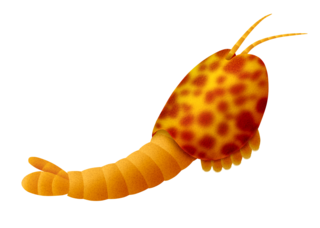
Pauloterminus is an extinct genus of bivalved arthropod known from Early Cambrian Sirius Passet locality of northern Greenland. It is tentatively classified under the family Waptiidae.
Procaris hawaiana is a species of shrimp in the family Procarididae, from Maui, Hawaii. The species is very similar to Procaris ascensionis from Ascension Island. In P. ascensionis the integument is less firm, the rostrum is shorter, the cervical groove is more distinct, and the third abdominal somite reaches less far posteriorly over the fourth; also the scaphocerite has the final tooth still less distinct than in P. hawaiana, and the last segment of its antennal peduncle is less slender.
Periclimenes pholeter, is a species of shrimp belonging to the family Palaemonidae. The species is closest to Periclimenes indicus, P. obscurus and P. toloensis, resembling these species in the presence of an epigastric tooth on the carapace, the shape of the abdomen, the spinulation of the carapace, and the unarmed fingers of the first chelipeds. P. pholeter most resembles P. indicus by the elongatecarpus and long fingers of the second pereiopods, differing in these features from P. toloensis, which has the fingers slightly less than half as long as the palm. In P. obscurus the fingers are shorter than the palm, but the carpus is about as long as the palm. From P. indicus, this species differs: by the greater size; by the much higher rostrum and the greater number of ventral rostral teeth; by the shorter eye; by the less slender antennular peduncle; by the more deeply cleft upper antennular flagellum; by the more robust scaphocerite; by the fingers of the first pereiopods ; by the more slender pereiopods, especially the fifth, which is much longer than the ischium.

Heteromysis is a genus of marine mysid crustaceans from the family Mysidae, associated with various shallow-water invertebrates. The name describes differentiation of its pereiopods as possible adaptation to commensal life-style. Heteromysis is one of the largest mysid genera, containing more than 100 species. The genus is distributed globally, but predominantly in tropical and subtropical waters.

Kylinxia is a genus of extinct arthropod described in 2020. It was described from six specimens discovered in Yu'anshan Formation in southern China. The specimens are assigned to one species Kylinxia zhangi. Dated to 518 million years, the fossils falls under the Cambrian period. Announcing the discovery on 4 November 2020 at a press conference, Zeng Han of the Nanjing Institute of Geology and Paleontology, said that the animal "bridges the evolutionary gap from Anomalocaris to true arthropods and forms a key ‘missing link’ in the origin of arthropods," which was "predicted by Darwin’s evolutionary theory." The same day the formal description was published in Nature.
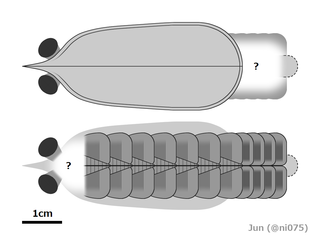
Erratus is an extinct genus of marine arthropod from the Cambrian of China. Its type and only species is Erratus sperare. Erratus is likely one of the most basal known arthropods, and its discovery has helped scientists understand the early evolution of arthropod trunk appendages. Some of the stem-arthropods like radiodonts did not have legs, instead they had flap like appendages that helped them swim. Erratus on the other hand had not only flaps but also a set of primitive legs. It also supported the theory that the gills of aquatic arthropods probably evolved into the wings and lungs of terrestrial arthropods later in the Paleozoic.

Boreomysis inopinata is a species of mysid crustaceans from the subfamily Boreomysinae. It is also a member of the nominotypical subgenus Boreomysis sensu stricto. The species is a deepwater bathypelagic mysid, found only from the Tasman Sea off Australia.

Tyrannosculda is an extinct genus of mantis shrimp which lived during the Late Jurassic in southern Germany. It was named in 2021, with T. laurae as the type and only species. Several fossil specimens are known, representing various growth stages.
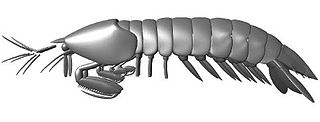
Tyrannophontes is an extinct genus of mantis shrimp that lived during the late Carboniferous period in what is now the Mazon Creek fossil beds of Illinois. It is the only genus in the family Tyrannophontidae. The type species, T. theridion, was described in 1969 by Frederick Schram. A second, much larger species, T. gigantion, was also named by Schram in 2007. Two other species were formerly assigned to the genus, but have since been reclassified.

Daidal is an extinct genus of mantis shrimp that lived during the Carboniferous period. It is the only genus in the family Daidalidae. Three species are currently placed within the genus. Fossils of the type species, D. acanthocercus, have been found in the Bear Gulch Limestone of Montana. A second species, D. pattoni, is known from the Lower Limestone Formation of Scotland, and the third species, D. schoellmanni, was discovered in Westphalia, Germany. The genus has been proposed to be polyphyletic, with D. pattoni possibly being an earlier diverging lineage, though more specimens and research are needed to confirm this.

Sculda is an extinct genus of mantis shrimp known from the late Jurassic to late Cretaceous of Germany and Lebanon. Although several species have been assigned to it, some are now deemed dubious or moved to different genera. It was a moderate-sized crustacean, measuring no more than 50 mm (2.0 in) long. Sculda would have lived in a marine environment and been a predatory animal, likely smashing its prey with the widened segment of its raptorial appendages before cutting it with the sharp appendage tips.
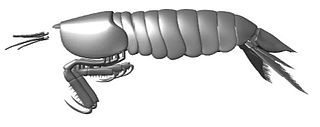
Gorgonophontes is an extinct genus of mantis shrimp that lived during the late Carboniferous period in what is now the United States and Belgium. It contains two named species. The type species, G. peleron, was described in 1984 by Frederick Schram based on 100 specimens found in Nebraska and Iowa. A second species, G. fraiponti, was first named from multiple specimens found near Liège in 1922 and later reassigned to the genus.
Chabardella is an extinct genus of mantis shrimp which lived during the Late Carboniferous in France. It was named in 2009, with C. spinosa as the type and only species.
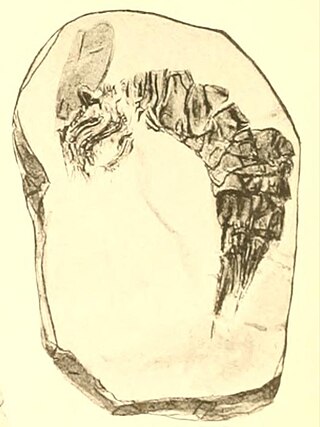
Bairdops is an extinct genus of mantis shrimp that lived during the Early Carboniferous period in what is now Scotland and the United States. Two named species are currently assigned to it. The type species, B. elegans, has been collected from several Dinantian-aged localities in Scotland, and was first described in 1908 by British geologist Ben Peach as a species of Perimecturus. The generic name was coined decades later in 1979 by American paleontologist Frederick Schram, and honors William Baird. A later species, B. beargulchensis, was named in 1978 after the Serpukhovian-aged Bear Gulch Limestone of Montana where it was discovered. The two species were originally deemed close relatives based on their physical similarities, but several cladistic analyses published since 1998 have suggested the genus may be polyphyletic.

Perimecturus is an extinct genus of mantis shrimp that lived during the Early Carboniferous period in what is now Scotland and the United States. The first known specimens were collected near the River Esk in Glencartholm, Scotland, and the genus was named in 1908 by Ben Peach, making it the second genus of Paleozoic mantis shrimp to be described. While many species have been classified in the genus since then, taxonomic revisions in the late 20th and 21st centuries have reassigned most of these to different genera, leaving two named species currently assigned to this genus. The type species, P. parki, was first named in 1882 as a species of Anthrapalaemon and is known from the Viséan-aged Glencartholm Volcanic Beds of Scotland. Fossils of a later species, P. rapax, have been found in the Bear Gulch Limestone of Montana and were first described by Frederick Schram.
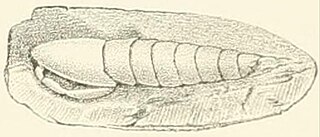
Archaeocaris is an extinct genus of mantis shrimp that lived in North America during the Early Carboniferous period. Though it was placed as a member of the family Perimecturidae until 2008, it is currently deemed the only genus in the family Archaeocarididae, and contains two species. The type species, A. vermiformis, was described by Fielding Bradford Meek in 1872 from specimens collected at the base of the Waverly Group in Kentucky. A second species, A. graffhami, was named by Harold Kelly Brooks in 1962 based on a fossil found in the Caney Shale of Oklahoma, with additional remains later found in the Pilot Shale of Nevada.
Ursquilla is an extinct genus of mantis shrimp that lived in Israel and Jordan during the Campanian stage of the Late Cretaceous period. It contains a single species, Ursquilla yehoachi.















